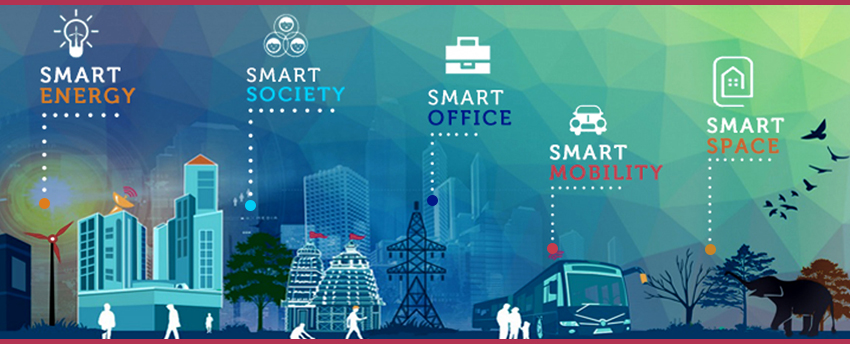Smart City know-how – why and how?
Smart City know-how – why and how?
The concept of smart cities have become more and more important nowadays from many aspects, such as innovation, environment, and development. Where are we now in the process, and what can we expect?
Nowadays environmental friendliness has gained importance in the case of households as well as business life. People are starting to realise that the resources of our planet are coming to an end; and most big companies have been trying to do everything they can in order to maintain development in an eco-friendly way.
Fortunately today you don’t have to “choose” between technology and eco-friendliness – since one can be in service of the other. This is why the concept of the so-called “smart city” could be created, the point of which is to carry out development works in a given city with the help of new technologies and innovations. IoT technology, Augmented and Virtual Reality, and technologies based on Big Data are all present in a smart city.
Of course, just like all kinds of innovation, a smart city should primarily serve the people who live there or visit the place; you have to apply technology and create new solutions to make people’s lives better. That’s why it is also very important to educate people who live in the area, to make the less advanced social groups grow intellectually and socially, and make modern devices widespread and available to everyone – this means that the concept of a smart city can only come true with the help of its inhabitants.
Smart city – how?
Many things fall into the category “smart city” – you can consider every solution that uses smart technology in order to make a city more livable part of a smart city. In this sense, mobile applications which present the city itself, the surroundings or the routes around the city are also part of a smart city.
This, however, is not enough to “smarten up” a city. In more developed countries in Western Europe or Scandinavia they use smart technology to make waste disposal easier, to monitor traffic in real time, or even to optimise public transport. The most important tools to do this are different types of sensors installed citywide (which are capable of recording either image or sound), and networks connected to those sensors, which transfer the information in the appropriate manner and to the appropriate part of the network, so that city management can take the necessary steps – which steps may also be automated, but human resources can also be used.

A smart city can be the best solution in order to satisfy the needs of its inhabitants, to make the jobs of those who work in city (or country) management easier, and to improve public safety and people’s sense of security and quality of life. Smart cities are developing fast – let’s see where we are now and what solutions are still under construction.
Safety
One of the most important aspects of smart cities is safety. The first thing landscape and city architects would like to reach is to reduce criminal activities, and to make the job of police officers easier.
This can be done with new devices such as automated CCTV cameras and sound recognition sensors, which can help filter out and identify criminal activities. Sound sensors, for example, are able to identify the sound of a gunshot; moreover, they can also transfer it to the appropriate bodies. This is needed because inhabitants are often afraid, and they don’t dare go to the police and report a crime. With the help of IoT, you can even provide security solutions at a public event (like a concert, festival, or demonstration).
Smart technology, however, has its drawbacks, too. For instance, if you install cameras in order to make the city safer, you also decrease the personal space of the inhabitants. City architects have to find the balance where people are feeling safe, but at the same time, their personal space is not invaded.
Public lighting
Safety is heavily connected to public lighting as well. Smart LED lights, for example, are capable of emitting a brighter light when more people are in one place, but become dimmer when there is no one around. With this, besides improving public safety, you can save a significant amount of energy and time, which is, on one hand, really environmentally friendly, and on the other hand, it can also reduce light pollution in cities.
Plus, the installation of smart lightbulbs creates workplaces, too. In Denmark, there is a separate industry built on developing and maintaining different smart lighting solutions.
Parking
Have you ever tried to find a parking space in Budapest? If you have, then you know that it is not an easy task, especially in more frequented areas, and around places where parking is free. The technologies of smart cities make your life easier when it comes to parking, too. In Paris, for example, you can find the parking space nearest to you with a mobile application. Parking spaces are identified with parking sensors, which forward the data to the application as well. France was one of the first European countries to introduce this solution, and since they have been using it, the number of traffic jams in the city has reduced significantly.
So as you can see, with such an application you not only make driving a car in the city easier, but you can also save a lot of time, money and fuel – which provides a sustainable future (and city) for both the consumer and the environment.
Public transport
It is not only those who travel by car whose lives will be easier because of the technologies of a smart city. There have been significant developments concerning public transport, too. You can see this if you just think about the mobile app available in Budapest, which shows you in real time when the next bus is coming, or when and where you should get on a different vehicle.
However, the list of innovations concerning public transport doesn’t end here. There are more and more cities where an electronic ticket system is used, and where there are automatic gates at metro and train stations. With these solutions, you can avoid “jams” at stations day by day, even at peak times, because people can only enter these stations with the touch of a card – there is no need for queues or ticket inspectors. Ever since these systems have become more widespread, public transport has become one of the most important ingredients of a smart city.
By making public transportation smart, you can also make predictions about when a bus or a tram has a bigger number of travellers, or how long exactly is the transportation time between two stops. The only thing you need for this is sensors inside the vehicles, which works kind of like a “counting device.” That way, with the help of big data and analytics you can work out a public transport schedule which is ideal for those who use public transport on a daily basis.
Smart city – happy inhabitants
As you can see, there are a number of technologies available in order to make cities smart. As a result of this, it’s not only the cityscape that can be more appealing, but people who live there or visit can also have a more pleasant experience.
As for Hungary, there is still room for improvement in this field. However, developments have already started; plus, thanks to Big Data and IoT, the first “smart city” projects have already been established, and we can expect more developments in the future.


